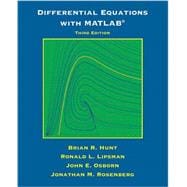A supplemental text that can enrich and enhance any first course in ordinary differential equations
This supplement helps instructors move towards an earlier use of numerical and geometric methods, place a greater emphasis on systems (including nonlinear ones), and increase discussions of both the benefits and possible pitfalls in numerical solution of ODEs. By providing an introduction to the software that is integrated with the relevant mathematics, Differential Equations with MATLAB can perfectly complement and enhance other texts from Wiley.
Since the third edition of Differential Equations with MATLAB first appeared in 2012, there have been many changes and enhancements to MATLAB and Simulink. These include addition of live scripts, new plotting commands, and major changes to the Symbolic Math Toolbox. This revised version brings the text completely up to date with the 2019a release of MATLAB.









